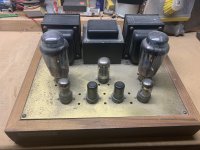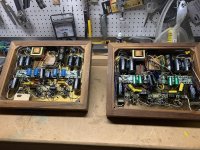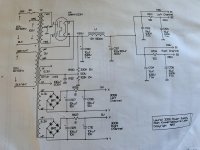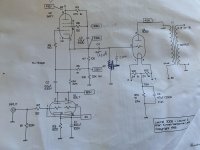I built 2 Welborne Labs Laurel 300B Stereo amps back in 1998. One for me, one for an uncle. My cousin now has the one I built for my uncle, and he gave to to me over the holidays to look it over. I don't think he used it.
Status:
Mine - I used it in my main system a solid 7-8 years, then for the next 7 years it was 50/50 between the 300B amp and a Pass Aleph 3. Mine has been idle for probably 5 years, but I'm considering it in a secondary system.
Looking back at papers in my audio docs, it looks I did some upgrades in 2007 after blowing a WE300B. That was not a pleasant day... I had to replace a few parts, and then took the opportunity to "upgrade" some caps. Comparing the 2 amps and my notes, it looks like I changed R106 & R107 from 0R8 to 1R5, and i recall that was to drop the voltage on the 300B filaments a touch. I was measuring a over 5V based based on whatever my line voltage was at that home. Looks like that took my voltage to 5V on the channels after the mod. I also used a CV378 instead of a 5AR4 to get B+ down closer to what is on the schematic.
My cousin's amp came to me as it was built in 1998, no mods. It had a blown fuse and PSU cap C100 (first cap after 5AR4 and before choke) was loose. One of the solder joints came loose. I fixed that on the bench. Everything else appears normal. I have a feeling the amp has very little use over it's lifetime.
I was thinking I will fire them up, check things out, and send the amp back to my cousin. Then I thought it may be time for a re-cap of the electrolytics. They're 22 years old. In addition, we have better caps in 2020 than 1998... So I'm thinking now is the time to set them up for the next 20+ years of useful service.
Any input / thoughts on doing the following:
Replace C101 (100uF+100uF/500V Elna Cerafine) with modern 220uF / 500V cap.
https://www.digikey.com/products/en?keywords=565-3602-ND
Side note - I can't believe the prices the NOS 100uF+100uF/500V Elna Cerafine's are fetching. $200+
Are there any compelling reasons to consider a multiple cap like another 100+100 vs. swapping to a single 200uF or 220uF?
Replace C107-C110 (10kuF / 10V) with modern Vishay 10kuF / 10V
https://www.digikey.com/products/en?keywords=BC5024-ND
Replace C113 with (100uF / 200V Elec) with modern Vishay 100uF / 200V
https://www.digikey.com/products/en?keywords=4182PHBK-ND
Replace C1 (100uF / 50V Black Gate) with 100uF / 50 Elna Silmic II
https://www.digikey.com/products/en?keywords=604-1120-ND
I chose the PSU caps for long life and looks it like the rest of the specs exceed the old caps.
For the mu stage, I've had good luck with Silmic II's on the First Watt clone builds I've done, so I'm going to go with what I know there. And the price is right.
Then I'm thinking of doing the updated R106 and R107, too.
Thoughts?
Status:
Mine - I used it in my main system a solid 7-8 years, then for the next 7 years it was 50/50 between the 300B amp and a Pass Aleph 3. Mine has been idle for probably 5 years, but I'm considering it in a secondary system.
Looking back at papers in my audio docs, it looks I did some upgrades in 2007 after blowing a WE300B. That was not a pleasant day... I had to replace a few parts, and then took the opportunity to "upgrade" some caps. Comparing the 2 amps and my notes, it looks like I changed R106 & R107 from 0R8 to 1R5, and i recall that was to drop the voltage on the 300B filaments a touch. I was measuring a over 5V based based on whatever my line voltage was at that home. Looks like that took my voltage to 5V on the channels after the mod. I also used a CV378 instead of a 5AR4 to get B+ down closer to what is on the schematic.
My cousin's amp came to me as it was built in 1998, no mods. It had a blown fuse and PSU cap C100 (first cap after 5AR4 and before choke) was loose. One of the solder joints came loose. I fixed that on the bench. Everything else appears normal. I have a feeling the amp has very little use over it's lifetime.
I was thinking I will fire them up, check things out, and send the amp back to my cousin. Then I thought it may be time for a re-cap of the electrolytics. They're 22 years old. In addition, we have better caps in 2020 than 1998... So I'm thinking now is the time to set them up for the next 20+ years of useful service.
Any input / thoughts on doing the following:
Replace C101 (100uF+100uF/500V Elna Cerafine) with modern 220uF / 500V cap.
https://www.digikey.com/products/en?keywords=565-3602-ND
Side note - I can't believe the prices the NOS 100uF+100uF/500V Elna Cerafine's are fetching. $200+
Are there any compelling reasons to consider a multiple cap like another 100+100 vs. swapping to a single 200uF or 220uF?
Replace C107-C110 (10kuF / 10V) with modern Vishay 10kuF / 10V
https://www.digikey.com/products/en?keywords=BC5024-ND
Replace C113 with (100uF / 200V Elec) with modern Vishay 100uF / 200V
https://www.digikey.com/products/en?keywords=4182PHBK-ND
Replace C1 (100uF / 50V Black Gate) with 100uF / 50 Elna Silmic II
https://www.digikey.com/products/en?keywords=604-1120-ND
I chose the PSU caps for long life and looks it like the rest of the specs exceed the old caps.
For the mu stage, I've had good luck with Silmic II's on the First Watt clone builds I've done, so I'm going to go with what I know there. And the price is right.
Then I'm thinking of doing the updated R106 and R107, too.
Thoughts?
Attachments
Last edited:
Looking back at papers in my audio docs, it looks I did some upgrades in 2007 after blowing a WE300B. That was not a pleasant day...
The 300B grid leak (R11) shows 330K, which is out-of-spec. It's 250K max. for auto-bias, WE data. With pricey tubes, I would say that 200K is high enough, especially with a 220nF coupling cap.
Any input / thoughts on doing the following:
Replace C101 (100uF+100uF/500V Elna Cerafine) with modern 220uF / 500V cap.
https://www.digikey.com/products/en?keywords=565-3602-ND
Side note - I can't believe the prices the NOS 100uF+100uF/500V Elna Cerafine's are fetching. $200+
Are there any compelling reasons to consider a multiple cap like another 100+100 vs. swapping to a single 200uF or 220uF?
Yes, Cerafines are horrible - they fail short-circuit, even when operated well within ratings.
$200 for sure-to-fail elderly bad caps ? Perhaps some tweakers like to pay extra to live dangerously.
Electrolytics sound bad after 10 years, IME, so I think you will be glad when the amp is restored with new caps.
Kemet ALS/ALT series caps are much higher quality than ordinary Snap-ins, for a little extra cost. They have 550V rated parts too.
Multiple caps in a can are for restorations only, IMHO. Single parts are better quality and longer lasting, generally
I would bring up the amp slowly with a Variac, to lessen the chance of a sudden electrolytic capacitor
failure after the long lack of use.
failure after the long lack of use.
Thanks for the feedback!
Is it as simple as swapping out 330k for a 200k resistor?
Are there any calculations I need to consider, things to measure (voltages, bias, etc.) or other components to swap? I don't want to blow another WE 300B. Also I don't want to make several parts order for where the part is $0.15 and the shipping is $9.00
The 300B grid leak (R11) shows 330K, which is out-of-spec. It's 250K max. for auto-bias, WE data. With pricey tubes, I would say that 200K is high enough, especially with a 220nF coupling cap.
Is it as simple as swapping out 330k for a 200k resistor?
Are there any calculations I need to consider, things to measure (voltages, bias, etc.) or other components to swap? I don't want to blow another WE 300B. Also I don't want to make several parts order for where the part is $0.15 and the shipping is $9.00
Thanks for the feedback!
Is it as simple as swapping out 330k for a 200k resistor?
Are there any calculations I need to consider, things to measure (voltages, bias, etc.) or other components to swap? I don't want to blow another WE 300B. Also I don't want to make several parts order for where the part is $0.15 and the shipping is $9.00
Grid Leak resistor: a Professional quality metal film 1W part is worth the extra few pennies. 1W professional types have the highest stability & reliability. 1W also means a 500V operating voltage spec., which is the kind of margin we want, given that 100V peak are expected.
The Vishay Beyschlag is a good example (Mouser PN 594-E0414C200K0F1A ).
For long life of the 300B, there are two essential measurements:
1. Filament Voltage.
This should be 5.0V at all times. The nearer to 5.0V the longer it lasts: Vf is a limiting factor for long-lived 300Bs (WE and EML for example). Mains tolerance is a real problem for unregulated supplies. Outside the range 4.75V to 5.25V the lifetime is certainly degraded.
2. Anode/Plate power dissipation
This is easy to measure with your auto-bias amplifier: it's the 75V on R14. 75V on 1K is 75mA, and if the anode voltage is 415V as marked, the power is (340 x 0.075) = 25.5W.
Keeping the power dissipation to below 28W in a WE 300B will greatly help with lifetime.
Hmmm ... it's interesting.Yes, Cerafines are horrible - they fail short-circuit, even when operated well within ratings.
I use 500V Cerafines (I bought a lot long time ago at a reasonable price) at least about a decade in my amplifiers, but none of them failed.
Some lost a little its capacity (for example in my A2 capable 300B SE, which is a "little" hot 🙂 ), but still working.
IMHO -together BGs- except its amazingly high price, these are excellent HV capacitors.
My cerafines were 1997 production. 3 of 4 failed, all short-circuit within 3-4 years of little use (despite operation well within ratings, and <30°C - not used at the power rectifier - but driver power supply). Perhaps early ones were worse. But normal electrolytics don't fail short circuit IME, and I would not take the risk on them.
The failures were probably very helpful to me. Now, I do not buy expensive versions of standard capacitors - I try to design circuits that eliminate the influence of them.
In he case of the 300B driver circuit - my Shunt Cascode driver does not run any signal current through the supply capacitor, and any capacitor across the driver supply sounds the same.
The failures were probably very helpful to me. Now, I do not buy expensive versions of standard capacitors - I try to design circuits that eliminate the influence of them.
In he case of the 300B driver circuit - my Shunt Cascode driver does not run any signal current through the supply capacitor, and any capacitor across the driver supply sounds the same.
Last edited:
- Home
- Amplifiers
- Tubes / Valves
- Welborne Labs Laurel 300B Stereo Mods




